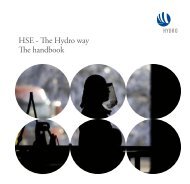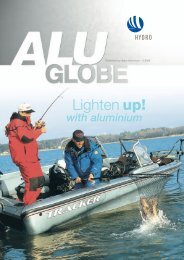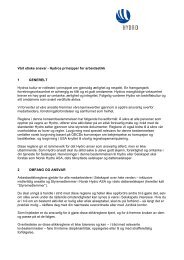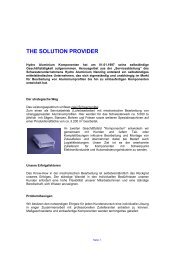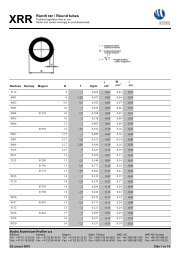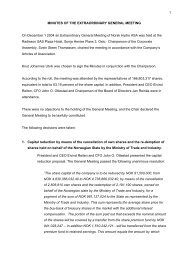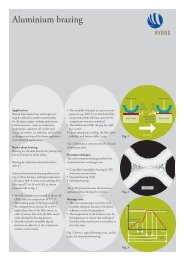Create successful ePaper yourself
Turn your PDF publications into a flip-book with our unique Google optimized e-Paper software.
Team co-ordinator Michael Wilson and his colleagues at<br />
Kurri Kurri are benefiting from improved safety performance<br />
and the Safety Maintenance Center.<br />
T<br />
he aluminium smelter in Kurri<br />
Kurri, Australia, distributed close<br />
to 13,000 pieces of safety equip-<br />
ment to employees last year – a lot to<br />
keep track of. That’s the job of the Safety<br />
Maintenance Center.<br />
“When we issue a piece of safety equip-<br />
ment, we know it is according to Australian<br />
and site safety standards. It has not been<br />
lying around in the back of a car the last six<br />
months, with paint all over it,” says site safety<br />
officer Jim York.<br />
Together with assistant safety officers<br />
Gregory Cook and Simon Lane he inspected<br />
and issued close to 13,000 pieces of safety<br />
gear in 2006. This includes 3,764 Racal hel-<br />
mets, 1,791 harnesses and 1,789 lanyards.<br />
The process and results of the system are<br />
impressive, making the Safety Maintenance<br />
Center a significant contributor to a record low<br />
total recordable injury statistic of 2.1 in 2006.<br />
In addition, <strong>Hydro</strong> saves big money through<br />
loss prevention.<br />
It wasn’t always that way. Ten years ago,<br />
each worker had individual safety gear, and<br />
50 Racal helmets, each priced at around<br />
$800, were lost every year. Other equipment<br />
was misplaced and lost, and – very import-<br />
ant – safety equipment was not inspected<br />
regularly.<br />
Last year, though, only one of the Racal<br />
helmets was not returned. The Safety Main-<br />
tenance Center then could identify who had<br />
been issued the helmet, and the department<br />
in question had to replace it.<br />
Since all equipment is tagged and all activi-<br />
ties logged on a computer, the use of safety<br />
equipment can be optimized in cooperation<br />
with the manufacturer. One example is Racal<br />
helmet filters. The center now knows exactly<br />
how many times each of the 110 helmets has<br />
been used. York estimates the annual savings<br />
on filters alone to be around $30,000.<br />
“The people working at the Safety Maint-<br />
enance Center are all certified to inspect the<br />
safety equipment we issue. All equipment is<br />
clearly tagged and identified, has its designat-<br />
ed storage area, and we know exactly when<br />
it expires or requires servicing. We dismantle,<br />
clean, and inspect everything before it is re-<br />
issued,” says York.<br />
Based on this success, all contractors<br />
working at the smelter are also offered the<br />
use of safety equipment from the center.<br />
hi! > Halvor Molland<br />
photos > Halvor Molland<br />
Safety officer Jim York (right) and assistant Gregory Cook inspect a Racal helmet at the Safety Maintenance Center in Kurri Kurri, Australia.<br />
safety first hi! 5<br />
– 25%<br />
Goal!<br />
<strong>Hydro</strong> made its goal of a<br />
20 percent drop in the total<br />
number of injuries in 2006<br />
– by a good margin.<br />
The number of total recordable<br />
injuries (TRI) has been<br />
falling steadily over time,<br />
although the ambitious target<br />
of a 20 percent reduction in<br />
injuries set by President and<br />
CEO Eivind Reiten has not<br />
been reached every year.<br />
Last year, though, the trend<br />
was very positive – a reduction<br />
of around 25 percent, for<br />
a TRI rate of 4.0. The reduction<br />
in the TRI rate for 2005<br />
was 10 percent.<br />
“Certain business areas<br />
have achieved great improvements,”<br />
says Jack Simensen,<br />
head of safety in the corporate<br />
Health, Safety and Environment<br />
department. “Several<br />
units have achieved an improvement<br />
of more than 50<br />
percent, but we still have a<br />
list of units that are lagging<br />
behind, and unfortunately<br />
certain units also have reported<br />
a setback. This of course<br />
gives grounds for follow-up.”<br />
Despite the overall improvement,<br />
<strong>Hydro</strong> experienced one<br />
workplace fatality in 2006.<br />
Jens Hinrichs, a project engineer<br />
at the aluminium extrusion<br />
plant in Birtley, England,<br />
died in an accident in early<br />
November.<br />
“Every fatal accident is one<br />
too many,” Simensen says,<br />
adding that the number of<br />
fatal accidents has also fallen<br />
over time.<br />
The fatal accident at Birtley<br />
has been investigated, and a<br />
report has been distributed<br />
on the <strong>Hydro</strong> intranet so that<br />
others can learn from the<br />
experience.



